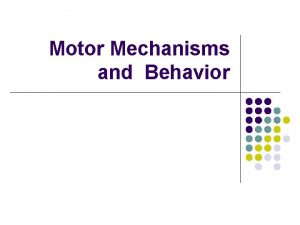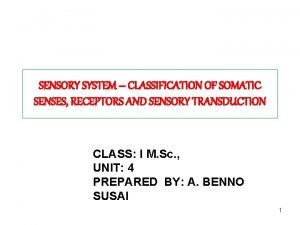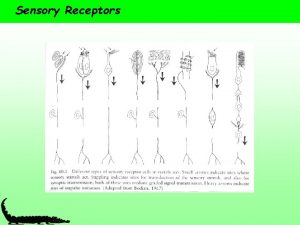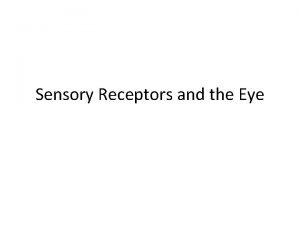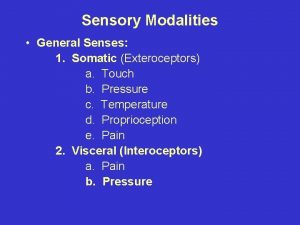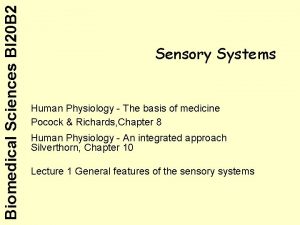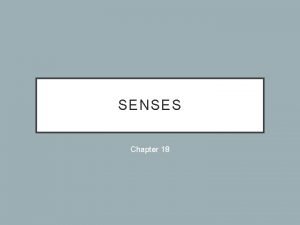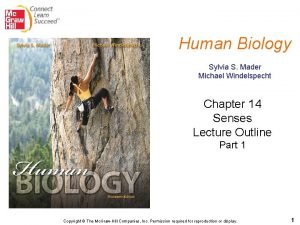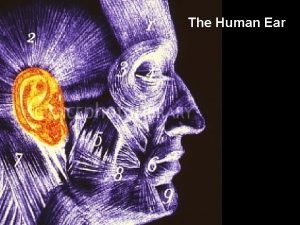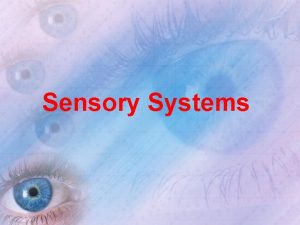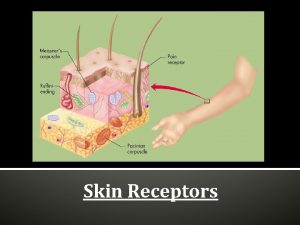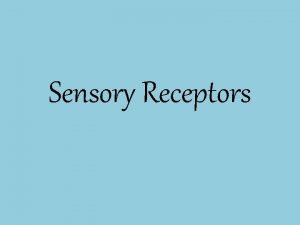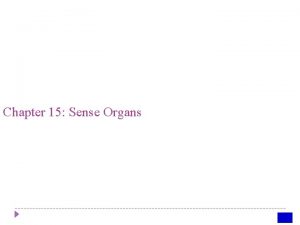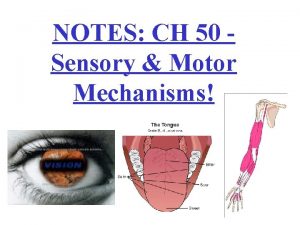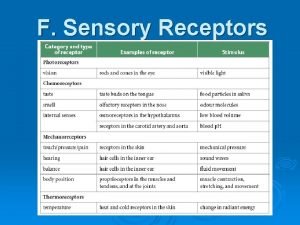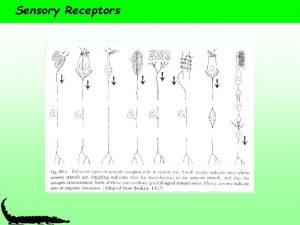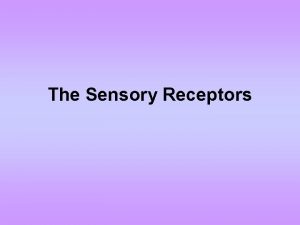Chapter 49 Sensory and Motor Mechanisms Sensory receptors













- Slides: 13

Chapter 49 Sensory and Motor Mechanisms

Sensory receptors and the central nervous system �When a sensory receptor detects a stimuli, it goes through a change in its membrane potential called sensory transduction �During sensory transduction a sensory receptor’s receptor potential increases �If a stimuli’s energy is increased it is called amplification �Once the stimuli energy has been transduced into receptor potential, it is then transmitted to the central nervous system (CNS) as action potential. Stronger receptor potential causes more frequent action potential to be sent. �Eventually sensory adaptation may take place, in which responsiveness to a stimuli decreases due to continued stimulation.

Types of Sensory receptors Mechanoreceptors: pressure, touch, stretch, motion, and sound Chemoreceptors: General internal proccesses Ex. Osmoreceptors detect your blood has become more concentrated, so you become thirsty to dilute it back to a normal concentration. Electromagnetic receptors: light energy such as visible light, electricity and magnetism Thermoreceptors: Heat and cold Pain Receptors: aka nociceptors are located in the epidermis and as the name implies, they detect pain.

Hearing and Equillibrium Invertebrates have statocysts to help detect gravity and give organisms a sense of equillibrium As the statolith moves inside the statocyst, it gives organisms a sense of orientation. Hearing is controlled in mammals by pressure waves in the air travelling into you ear through your tympanic membrane (eardrum) A video explaining this process is available here http: //www. youtube. co m/watch? v=ah. Cb. Gjasm_ E

Equilibrium continued � Organs in the inner ear such as the utricle and saccule help mammals detect body position and equilibrium. � Hair cells in these organs respond to gravity and motion. � In other vertebrae such as fish, they have a lateral line system in which mechanoreceptors use pores and hairs to detect water flowing through.

Taste and Smell �Many animals use their sense of smell in particular as their main way of recognizing the world around them. �Gustation (taste) and olfaction (smell) are dependent on chemoreceptors �In humans, there are modified epithelial cells organized as taste buds. There are 4 types of tastes recognized, which are sweet, sour, salty, and bitter. A 5 th taste called unami (delicous/savory) is considered but not yet completely recognized

Smell continued Olfactory receptor cells line the upper portion of the nasal cavity and use their cilia to bind to odorant receptors. While this may seem independent rom the taste senses, they are actually very connected and can sometimes even block each other, such as how a stuffed nose decreases your sense of taste.

Vision Invertebrate tend to have a light detecting Ocellus, a primitive organ than scans for light Some have developed compound eyes, such as flies, whose eyes contain thousands of ommatidia (the facets on their eyes)

Vision continued Other invertebrates have single-lens eyes, where there is one small opening and it works almost like a camera lens, where is expands or shrinks depending on the situation Vertebrae however have a much more complex eye structure Much of it is explained in this video: http: //www. youtube. com/watch ? v=Jun. Cyi. Gfreo

Skeletons �Skeletons can be used for support, protection, and movement �There are three types of skeletons, hydrostatic, exo, and endo. �Hydrostatic skeletons consist of a closed body compartment filled with fluid. It’s mainly present in worms and cnidarians and they move by contracting their entire bodies. �Exoskeletons is the type that most arthropods and mollusks have and they consist of a hard outer encasement protecting a soft inside. Many are made of chitin. �Endoskeletons are present in humans and most animals we frequently encounter. They are mainly made magnesium carbonate and calcium carbonate. These skeletons are inside the animal and while they do allow much freedom of movement, they only protect the interior organs.

Muscles �Muscles contract in order to move skeletal parts, . �The following animation will explain how muscles contract and relax. http: //media. pearsoncmg. com/bc/bc_0 media_bio/bio flix/bioflix. htm? c 7 emuscle �There also other types of muscles such as cardiac muscle in your heart and smooth muscle in blood vessels for example.

Locomotion �Movement is one of the key traits of animals and it can be done in many ways �Some animals are more buoyant than others and can swim in the water, while others may move on land. Some animals have become very efficient at this, for example, a kangaroo moving at 30 km/hr uses the same amount of energy as one moving at 6 km/hr �Some animals are even able to defy gravity by having light bone structure and certain other features. �One way or another, all animals find someway to move, whether it’s how an eagle flies, a cheetah runs, or even how a sponge uses cilia to filter feed.

Images Work Cited � Statocyst: http: //www. doctortee. com/dsu/tiftickjian/bio 101/sensorysystems. html � Sensory receptors: http: //pmrscience. wikispaces. com/1. 2+The+Sense+of+Touch � Lateral Line System: http: //www. britannica. com/EBchecked/media/3409/Lateral-line-system-of-afish � Smell in humans: http: //www. nature. com/embor/journal/v 8/n 7/fig_tab/7401029_f 1. html � Flatworm vision: http: //wps. aw. com/wps/media/objects/1668/1708348/ebook/htm/campbell 7 e. htm? 49. 04 � Fly eye: http: //catchrandom. blogspot. com/2010/07/looking-at-world-throughmicroscope. html � Human eye: http: //www. youtube. com/user/DNAunion � All videos are hyperlinked by their URLs
 Altruisml
Altruisml Types of sensory receptors
Types of sensory receptors What are the different types of sensory receptors
What are the different types of sensory receptors Classification of sensory receptors
Classification of sensory receptors Sensory receptors in eye
Sensory receptors in eye Classification of sensory receptors
Classification of sensory receptors Classification of sensory receptors
Classification of sensory receptors Classification of sensory receptors
Classification of sensory receptors Sensory receptors
Sensory receptors Proprioceptors
Proprioceptors Fluid that bathes the sensory receptors of the inner ear
Fluid that bathes the sensory receptors of the inner ear Cranial fossa nerves
Cranial fossa nerves Foramen interventriculare
Foramen interventriculare Cranial nerves sensory and motor
Cranial nerves sensory and motor
